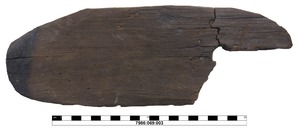
Paddle like shaped tool of elongated oval form with rounded edges, probably a field hoe. The object is not complete. A piece is missing from one of the narrow sides. The wood is comparatively soft, but all structures are still well recognizable. The ridges of the long sides run more or less straight, but pull in at ends, so that the changeover to the narrow sides are rounded. One of the long sides is rounded in profile, the other slightly pointed. This is also the case for the narrow sides. The pointed narrow side shows numerous carving marks, especially on one of the flat surface of the object, which clearly indicate the intention of thinning this area. Only at this part and on one of the flat sides there are also traces of burning or slight charring. This indicates an intentional surface alteration, often referred to in research as fire hardening. All the surfaces were worked with a sharp axe/adze or blade, as well shown by more than 100 tool marks. The working marks run diagonally in the direction of the pointed narrow side. The course of the growth rings and the rays suggests that the object was probably made from a previously splitted plank. Approximately 7.2 cm away from the narrow side with the flattened profile there is a hole of about 1.6 cm in diameter in the longitudinal axis of the object, which probably served for hafting. The hole is not round, but polygonal in shape, which provided a better fit for a handle. The hafting hole is comparatively small, so that only a thin handle can be considered. Thin handles can swing better and reduce impact shocks. Due to the pointed and probably fire-hardened narrow side, as well as the design of the shaft hole, an interpretation as a field hoe is probable.
Length: 28.9 cm. Width: 10.2. Height/Thickness: 1.4. Wood type: Pinus silvestris (CR 2018).
Dating: C14-analysis, Tübitak-0815, 95.4% probability: 833–781 BC (91.9%) and 892–880 BC (3.6%).